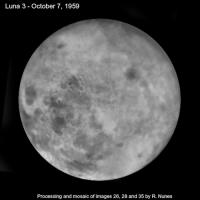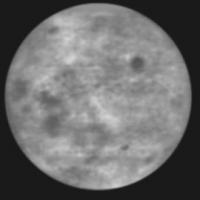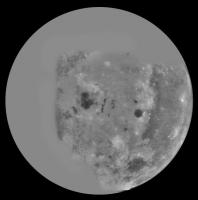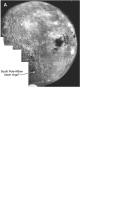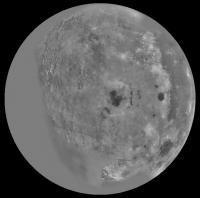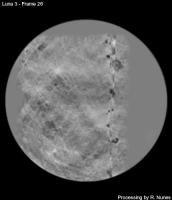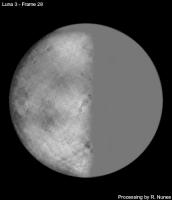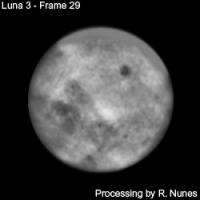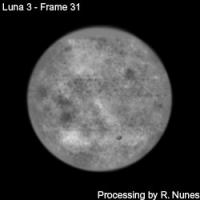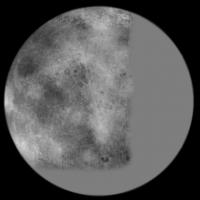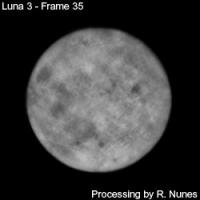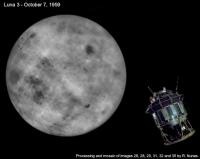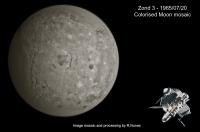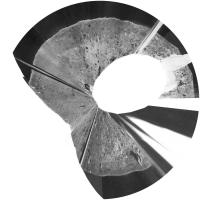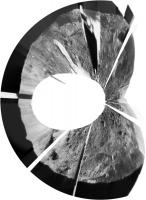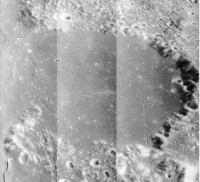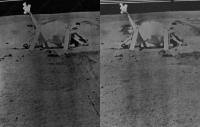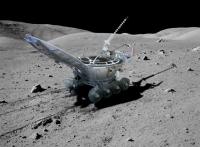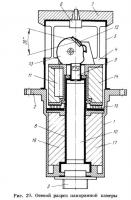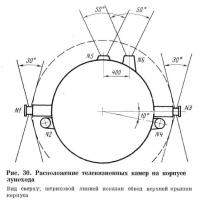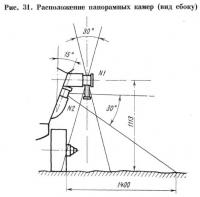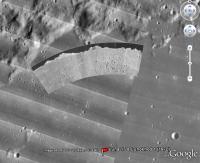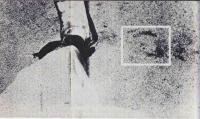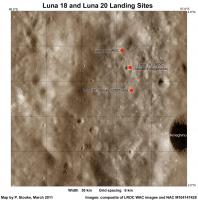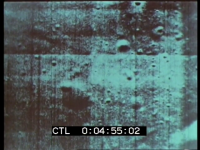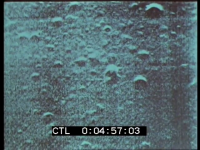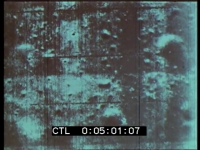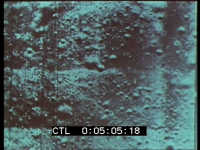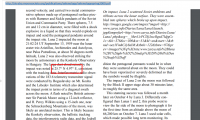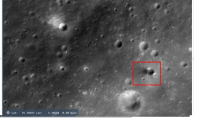Printable Version of Topic
Click here to view this topic in its original format
Unmanned Spaceflight.com _ Lunar Exploration _ Soviet Luna Missions
Posted by: PhilHorzempa May 4 2006, 03:05 AM
[size=2]
I thought that it was time to start up a discussion of what we know, or
would like to know, about the Soviet Luna Missions.
To start off, I have heard many a reference to the landing system utilized
by the early landers, such as Luna 9. However, I have yet to find a report,
or even a diagram, that shows the sequence of events, or such details as
the air bags. If such references do not exist, I hope that some of the UMSF
community have Russian contacts that could lead us to the source material
before it ends up in the dust bin of history.
In addition, I heard of an effort several years ago to obtain ALL of the imagery
from Lunakhods 1 and 2. Does anyone know if that effort was able to
secure that data?
Also, as far as Lunas 15, 18 and 23, the sample-return missions that didn't
quite make it home, are there any official reports "out there" that detail what
actually occurred to those missions? Or will we have to wait for the
high-resolution images from the LRO to determine their fates?
Another Phil
Posted by: BruceMoomaw May 4 2006, 06:27 AM
We had quite a detailed discussion of the Luna 4 through 13 lander missions in -- of all places -- the "I'm back from the Europa Focus Group meeting" thread down in the "Europa" section (which gives you some idea of how this site tends to wander around erratically from one subject to the next; we got there, somehow, via discussions of a possible lightweight lander design for Europa Orbiter). It turns out that there was an issue of "JBIS" a few years ago that provided extremely detailed information on these missions (plus the Luna 10 through 14 orbiters).
An earlier issue of JBIS detailed the very first Soviet Luna missions (1958 through 1960). I don't know whether there are any issues of that magazine (which does periodic issues on astronautics history, including the Soviet branch) that cover the later Lunas (1969-76), but I wouldn't be surprised. Once again, I'll have to take a look the next time I'm down at UC-Davis.
Posted by: tasp May 4 2006, 12:52 PM
Luna 23 and Luna 18 were apparently damaged by hard landings. I am just speculating, but perhaps the landing radar was confused by surface boulders and the retros cut out a little early.
Luna 15, I guess they are pretty sure was a sample return, crashed too. Considering the complexity of a sample return, a first attempt (is this known for sure?) might have gone awry in any number of ways. Considering the US Ranger series, (but not the Surveyors!), probably not too surprising.
Posted by: ljk4-1 May 4 2006, 01:53 PM
I saw a drawing of Luna 15 circa 1992 from the aerospace group that
used to put out annual reports on Soviet spacecraft and missions (could
someone help me with the name, please? Thanks.).
It looked exactly like Luna 16, which did land on the Moon and return
some surface samples successfully to Earth just over one year later.
Not a real surprise, but nice to know.
This Web site has what it labels to be an image of Luna 15, but can
anyone confirm this?
http://www.aerospaceweb.org/question/spacecraft/q0196.shtml
At least it wasn't a scenario out of the 1968 film Countdown where
Luna 15 was really a desperate manned attempt to beat the USA and
the Soviets ended up losing three cosmonauts.
http://www.imdb.com/title/tt0062827/
The Soviets were also trying to beat Apollo 11 to the Moon and return
with some surface samples before the US did as a sort of coup. No
doubt rushing too fast in this part of the Space Race cost us all a little
bit of a different place to study from the Moon.
There is a very funny story created by Dwayne Day in 1999 detailing
how Luna 15 was NOT an unoccupied vehicle:
http://www.astronautix.com/astros/bormp504.htm
Don P. Mitchell has an incredible collection of Soviet lunar probe
images, including many from the two Lunakhods:
http://www.mentallandscape.com/C_Catalog.htm
This is not to ignore or downplay anyone else's collection of similar
images, it's just that Mitchell appears to have the most I am aware of.
There are already some other UMSF threads that discuss the Soviet lunar
missions and have images from them as well:
http://www.unmannedspaceflight.com/index.php?s=&showtopic=1106&view=findpost&p=13362
http://www.unmannedspaceflight.com/index.php?s=&showtopic=908&view=findpost&p=9080
http://www.unmannedspaceflight.com/index.php?s=&showtopic=909&view=findpost&p=9101
http://www.unmannedspaceflight.com/index.php?s=&showtopic=1050&view=findpost&p=11828
http://www.unmannedspaceflight.com/index.php?s=&showtopic=1124&view=findpost&p=13688
Posted by: gndonald May 4 2006, 02:08 PM
The http://tinyurl.com/l7d4t website has a good timeline of the Luna probe series, for some of the pictures taken on those missions, http://www.mentallandscape.com/C_CatalogMoon.htm, is the best place to look.
Interestingly while Luna 15/18 were lost in crashes, Luna 23 landed with no problems but suffered a drill failure after landing, the Soviets apparently 'ran' the lander for a few days and then shut it down, however no images seem to have been released from the mission. (No pictures were taken by Luna 16 because the floodlights failed to switch on.) It would be interesting to know if any pictures were taken by Luna 23, or whether like Luna 24 the probe did not carry a camera.
Sorry for duplicating ljk-4's links but obviously we were typing at the same time.
Posted by: tedstryk May 4 2006, 02:45 PM
Luna 15, I guess they are pretty sure was a sample return, crashed too. Considering the complexity of a sample return, a first attempt (is this known for sure?) might have gone awry in any number of ways. Considering the US Ranger series, (but not the Surveyors!), probably not too surprising.
Also, Luna 15 was launched to beat Apollo 11 back to earth with the first samples to try to take some of Apollo's thunder. The propaganda lines would have spoken of how they returned samples at a fraction of the cost. But based on everything I have seen, they really needed more time to work on it (and, once they had that time, Luna 16 suceeded).
Posted by: gndonald May 4 2006, 04:54 PM
This is a follow up to my earlier post (see above). The information on Astronautix.com states that the Soviets continued to operate the lander portions of Luna 16/20/24 (The sample return craft) after the samples were launched towards Earth.
Similarly, the abortive Luna 23 mission also featured a period of lander operation, though in this case it would have been tied to the failed attempt to collect surface material.
It would appear that at least Lunar 16 and 20 were fitted with cameras, but it is unclear if Luna 23 was so equipped. Luna 24 (allegedly) had no cameras fitted.
Does anyone have a listing, rough or otherwise of what other instruments were fitted to the landers and on just how long the landers were operated after launch of the samples?
Posted by: Phil Stooke May 4 2006, 06:34 PM
Following up on a couple of points here... I'm on vacation and away from my usual resources...
The Russians are trying to collect everything and make it available through a website, similar to a PDS node. But they have no money for it. I have been close to the people involved, chiefly Kira B. Shingareva of MIIGAiK and Sasha Basilevsky of Vernadsky. Some material has been collected - big tapes with Lunokhod images from the State Archives, stuff stolen for later sale and now recovered, negatives scanned etc. But getting it all organized is another matter and the lack of money makes it very slow. Some has been done on a volunteer basis. So don't expect results for a long time. What we REALLY need is a philanthropist to put money into it. So email all your philanthropist buddies.
Lunas 15, 16, 18 and 20 plus the failed sample return launches from that period - all had cameras. Don Mitchell describes them on his site, referenced above. Luna 16, it appears now, DID take images. It landed at night and its lights failed, as noted above, but it took pics anyway. But they were mostly black with just a few spots of light from earthshine. They were never published. (This info from Basilevsky via Mitchell). I would dearly love to get my hands on the digital data, and I assume we could do a lot more with it using modern methods than was possible back in 1970. The later sample return missions had no cameras due to having a redesigned drill. The old camera was for targeting the old drill to a rock-free spot. The new drill couldn't be retargeted and also took up the camera's space and mass (I think).
Phil
Posted by: ljk4-1 May 4 2006, 07:20 PM
In the early 1990s, Andrew Lepage wrote in the online EJASA on a series
about the Soviet and US race to the Moon, focusing on then new information
about the lunar probes.
All of the EJASA issues from 1989 to 1996 are online here:
ftp://ftp.seds.org/pub/info/newsletters/ejasa/
Andrew's articles are in these issues:
"Mars 1994" - March 1990
"The Great Moon Race: The Soviet Story, Part One" - December 1990
"The Great Moon Race: The Soviet Story, Part Two" - January 1991
"The Mystery of ZOND 2" - April 1991
"The Great Moon Race: New Findings" - May 1991
"The Great Moon Race: In the Beginning..." - May 1992
"The Great Moon Race: The Commitment" - August 1992
"The Great Moon Race: The Long Road to Success" - September 1992
"Recent Soviet Lunar and Planetary Program Revelations" - May 1993
"The Great Moon Race: The Red Moon" - July 1993
"The Great Moon Race: The Tide Turns" - August 1993
"The Great Moon Race: The Final Lap - November 1993
"A Personal Adventure in Home Computing: The Origin of Comet
Shoemaker-Levy 9" - March 1994
"The Great Moon Race: The Finish Line" - July 1994
Posted by: Dyche Mullins May 4 2006, 08:42 PM
how Luna 15 was NOT an unoccupied vehicle:
http://www.astronautix.com/astros/bormp504.htm
This reminds me of the beautiful and brutally satirical Victor Pelevin novel, _Omon Ra_, in which none of the Soviet space probes was ever really UNmanned.
http://lib.ru/PELEWIN/omon_engl.txt
Posted by: ljk4-1 May 4 2006, 09:09 PM
http://lib.ru/PELEWIN/omon_engl.txt
According to the Phantom Cosmonaut section of Astronautix, apparently there
were rumors of a "KGB Dwarf" who secretly drove Lunakhod 1 on a one-way
suicide mission!
http://www.astronautix.com/astros/kgbdwarf.htm
"We travel together, passengers on a little space ship, dependent on its vulnerable supplies of air and soil . . . preserved from annihilation only by the care, the work, and I will say the love, we give our fragile craft." - Adlai Stevenson
Posted by: BruceMoomaw May 4 2006, 10:34 PM
If you REALLY like Luna 15 conspiracy theories, Allen Drury -- the Godawful right-wing political-thriller writer who got the Pulitzer for "Advise and Consent" in 1960 only because, after the Pulitzer board had awarded it to Saul Bellow, the newspaper publishers who own the Pulitzer Prize organization decided to take it away from Bellow and award it to Drury for writing an Important Political Novel -- wrote a lulu in 1970 called "The Throne of Saturn", in which Luna 15 was an unsuccessful attempt to bomb the Apollo 11 landing site and kill Armstrong and Aldrin because...because...well, just because.
were rumors of a "KGB Dwarf" who secretly drove Lunakhod 1 on a one-way
suicide mission!
Maybe they were circus clowns, and there were several of them onboard.
Posted by: gndonald May 5 2006, 03:19 AM
Hopefully the last word on Luna 15 conspiracies. The rpg magazine Dragon once ran a series of articles adapting the moon to different rpgs. One of these was called 'Zondraker' and dealt with espionage on the moon in a hypothetical 1980's.
One of the scenario outlines had the players visiting the Luna 15 site and discovering that rather than a Luna 16/18/23/24 style lander the probe was in fact a last ditch attempt to put a Cosmonaut on the moon.
Posted by: 4th rock from the sun May 6 2006, 01:48 AM
Finally I've finished one of my projects: merging various Luna 3 images to reduce noise, cover all of the moon's disk and replace missing data areas.
This is my final result and not that bad in my opinion ;-)
Much of the image resolution was lost in the noise, but the picture's dynamic range was recovered.
Posted by: tedstryk May 6 2006, 02:59 PM
Finally I've finished one of my projects: merging various Luna 3 images to reduce noise, cover all of the moon's disk and replace missing data areas.
This is my final result and not that bad in my opinion ;-)
Much of the image resolution was lost in the noise, but the picture's dynamic range was recovered.
Nice work! I had never thought of doing that!
Posted by: DonPMitchell May 7 2006, 02:45 AM
Very cool. Where did you find a good picture of frame 35?
I'm still trying to pry more Luna-3 pictures loose. To be honest, they are probably sitting in a drawer, scratched up, covered with dust. But I'm told the magnetic tape still exists, and there is a machine at IKI that can read it. I'm pressing some folks to do that.
I made this figure for my book, just to give people a reference for what they are looking at in the Luna-3 images. The clementine image is a texture-mapped sphere.
[attachment=5474:attachment]
So I guess this means the American Anti-Communist League was wrong. The Russians didn't fake the pictures.
Posted by: gndonald May 7 2006, 06:05 AM
Finally I've finished one of my projects: merging various Luna 3 images to reduce noise, cover all of the moon's disk and replace missing data areas.
This is my final result and not that bad in my opinion ;-)
Much of the image resolution was lost in the noise, but the picture's dynamic range was recovered.
You've done a magnificient job with that image, any plans to do the same thing with the Zond 3 far-side photos?
Posted by: 4th rock from the sun May 7 2006, 11:05 AM
Hum... I didn't !!!! I just used the clean parts from several frames to create the mosaic.
Here's what you get using the odd number frames. Photoshop does help here ;-)
I'm at (slow) work with those, but it's complicated because of spacecraft motion. Some kind of image projection will be needed to create a full mosaic.
So far, I've got this :-) from frames 3, 5 and 7:
Posted by: Phil Stooke May 7 2006, 08:19 PM
Here is a mosaic of Zond 3 images which I made a while ago. The early images over Oceanus Procelarum can't be fitted to the later ones. I apologise for the image size and quality, but I'm away from home and don't have my usual stuff with me.
Phil
Posted by: tedstryk May 7 2006, 10:37 PM
Very impressive.
This Zond image is another favorite of mine from the Soviet archive.
http://img102.imageshack.us/my.php?image=zondearthrise6em.jpg
Posted by: DonPMitchell May 9 2006, 10:02 AM
Oh wait, my mistake. I was thinking you used frame 32 for some reason.
I would love to get the signal off the Luna-3 tapes. They reprocessed some of them in 1965, and those images display considerably better quality.
[attachment=5504:attachment] [attachment=5505:attachment]
Posted by: DonPMitchell May 9 2006, 10:12 AM
This Zond image is another favorite of mine from the Soviet archive.
I was stunned when I saw the Zond-8 images. They are comparable to the Apollo photos in quality. They've scanned the original film at very high resolution. I've got all of them on my catalog site, but at 1/4 resolution to give media3.net a break.
Posted by: tedstryk May 9 2006, 10:25 AM
They are impressive. I have an archived that I may get around to scanning one of these years. I wonder if there are similar versions of the Zond 6 and 7 images, despite the fact that the Zond 6 shots have suffered greatly.
Posted by: 4th rock from the sun May 9 2006, 01:55 PM
I would love to get the signal off the Luna-3 tapes. They reprocessed some of them in 1965, and those images display considerably better quality.
Yes, that would be great. There is software that decodes fax images using a PC's soundboard. I've tired it on HF Fax transmissions, using a SW radio connected to the PC and it works.
So it would be as "simple" as converting the Luna 3 tapes to MP3 format. My guess is that the image information uses "regular sound" frequencies, so a simple convertion to MP3 would do.
Posted by: RJG May 9 2006, 07:54 PM
Be careful!
MP3 is a lossy compression technique using various methods to determine what to loose -including psychoacoustics. Obviously, if the audio signal is to be demodulated as a visual image, these losses may well manifest themselves as visible artifacts.
You would be better to convert to WAV which doesn't involve compression. Still easy to do but without leading to imperfections in the final image.
Rob
Posted by: 4th rock from the sun May 9 2006, 10:34 PM
Yes, that is true, but I was just thinking of a quick way to share such data (given that it even exists) and to try to decode it. Anyway, given the limited amount of information in such a transmission, I don't think that MP3 would degrade it much.
Anyway, some links with some info on HF-Fax that might be interesting at least to understand the basics of analog image transmission, as used on the Luna images.
http://www.hffax.de/html/live_charts.html
http://www.hffax.de/html/hf-fax.html
Posted by: DonPMitchell May 10 2006, 12:32 AM
Anyway, some links with some info on HF-Fax that might be interesting at least to understand the basics of analog image transmission, as used on the Luna images.
http://www.hffax.de/html/live_charts.html
http://www.hffax.de/html/hf-fax.html
Luna-3 images were FM video on a 25 kHz subcarrier. I think you'd want to get uncompressed WAV format, and then party on that with some good digital filters, like a high quality FM demodulator to start with.
Posted by: ljk4-1 May 10 2006, 11:32 AM
Sven Grahn has these pages on his Web site regarding Luna 3 and its frequencies:
http://www.svengrahn.pp.se/trackind/luna3/Luna3story.html
http://www.svengrahn.pp.se/radioind/Luna3beeps/Luna3beeps.html
http://www.svengrahn.pp.se/trackind/luna3/Yefimov.html
http://www.svengrahn.pp.se/radioind/lunaradi/lunaradi.htm
Posted by: DonPMitchell May 10 2006, 02:06 PM
http://www.svengrahn.pp.se/trackind/luna3/Luna3story.html
http://www.svengrahn.pp.se/radioind/Luna3beeps/Luna3beeps.html
http://www.svengrahn.pp.se/trackind/luna3/Yefimov.html
http://www.svengrahn.pp.se/radioind/lunaradi/lunaradi.htm
Sven does nice work. His research into the Jodrell Bank letters has been especially valuable. His estimate of the uplink frequency is in the ballpark -- the actual value was 102 MHz (5/9 times 183.6). That picture I sent him is an antenna from the Saturn system, which I've been told by someone in Russia was used for Luna-3. I'm a little skeptical now about that.
Posted by: 4th rock from the sun May 10 2006, 09:23 PM
...
Thanks for the links. I've read them all in detail and there are some interesting informations there:
There were 2 transmission modes, a Slow Mode and a Fast Mode. Total transmission times for a scan line and a complete picture are given, but they are inconsistent!
On the Slow Mode the rate was 1.25s per line with a total transmission time of around 30m. Well, 1000 lines would only take 1250s(~21m) to be transmited, so I think that is the accurate figure.
On the Fast Mode the transmission time is given as 15s for a whole frame, duration of a frame 10s !?!
These numbers don't make much sense. Perhaps a total transmission time of 1.5 minutes at ~0.1 seconds per line are the correct values?
Posted by: 4th rock from the sun May 10 2006, 11:45 PM
Phil
Hi again
If someone wants to go to trouble of reprojecting the images and assembling a complete mosaic I can provide the higher resolution originals. This wil be another of my ongoing projects...
Posted by: Decepticon May 11 2006, 01:21 AM
Thanks so much for posting that!
I've been wanting to see these images for a long time.
Posted by: edstrick May 11 2006, 09:41 AM
I've wanted to play with the Luna 3 images for years, but time, software availability (and time to learn to use it) and....
The original atlas of Luna 3 images had density sliced frames for some of the available images that could be histogram-matched and then merged into one dataset with extended dynamic range and less noise. The bigger part of the restoration would / should exist of removing or reducing periodic noise from the images with Fourier filtering: generate an image of just the periodic noise and subtract it from the raw image. Then further cleanup to remove noise-spike induced salt-and-pepper noise and readout and other artifacts.
Have at it!
The Zone 3 images could be mapped onto a sphere in something like 3 image sets and then registered and mosaiced.
I'd also *LOVE* to see a Zond 3 "movie".... Project each image on to the lunar sphere as viewed by Zond at the time of each image, then keeping the center of the sphere in the center of the frame and letting the sphere diameter vary as it did during the approach and flyby, make an animated gif / mov of the entire flyby with the frames displayed at proportional time intervals
Posted by: 4th rock from the sun May 12 2006, 12:00 AM
Just to see how much of the Moon was covered by the Zond images I made some crude reprojections to fill in the missing areas and came up with this. The image is as full resolution and a better result could be done with accurate reprojection and image averaging.
Posted by: DonPMitchell May 15 2006, 04:48 AM
Great Zond-3 mosaics!
To answer you question about Luna-3 transmision modes, the impression I have is that the early transmissions were very noisy, and they got higher quality pictures when the probe came back close to Earth. The images published in Lipsky's atlas are all slow-scan mode. The bands of static are periodic and consistant with the spin rate of Luna-3 (180 sec/rotation) after it finished photography and returned to spin-stabilized orientation. There was a dead spot in the radiation pattern of its antenna.
As far as I know, the only source of Luna-3 and Zond-3 images are prints of Lipsky's exposure-zone photos. I'm still trying to track down a real copy of the photos, and not a printed version. I just heard a few days ago that the Luna-3 magnetic tape is not located in the state archive institute, so we don't know where it is yet. My best guess now is that RNII KP has it.
I've gone off using the FFT method of descreening. What I do now is orient and resize the image so it is a 45 degree screen with exactly 5 pixels per vertical repeat. Then I filter it with a 5x5 custom box filter -- just go into the custom filter section of Photoshop and put a "1" in each box and set the weighting to 25. That box filter gives you a sinc function in the frequency domain, and it kills all the ink-dot harmonics completely. So much so, you can now sharpen the image as much as the noise level allows.
[attachment=5604:attachment] [attachment=5605:attachment] [attachment=5606:attachment]
For the rotation of the image, to make the screen 45 degrees, photoshop is fine. For the rescaling, I prefer to use the Lanczos-windowed sinc filter in ACDSee. There is a mistake in their filter that introduces a phase shift, but doesn't seem to bother too much (ACDSee is so buggy!). When I really care, I have a Kaiser-windowed sinc resampling routine I wrote in C++ that is rock solid.
Posted by: Phil Stooke May 15 2006, 06:42 AM
4th Rock, I am very impressed with your Zond 3 mosaics.
Phil
Posted by: 4th rock from the sun May 15 2006, 04:02 PM
Thanks all for the info and kind words!
I just found this on the internet: http://selena.sai.msu.ru
At least for me it's a new page!
Posted by: DonPMitchell May 15 2006, 04:35 PM
I just found this on the internet: http://selena.sai.msu.ru
At least for me it's a new page!
Yeah, I got a few of my catalog images there, it's where Lipsky worked. I've had indirect dealings with them. Look at the Russian site, not the English versions. There's a nice set of reports on Luna probes here:http://selena.sai.msu.ru/Home/Resear/Resear.htm and here:http://selena.sai.msu.ru/Home/moone.htm#Contact
Posted by: Bob Shaw May 15 2006, 06:43 PM
Don:
Perhaps, in your researches into the Soviet moon probes, you've come across some details which might relate to a subject we previously discussed on here. Bruce Moomaw has managed to persuade us that the hard-landing Luna vehicles used some form of airbags during the landing sequence - an element of that process which was new to most of us! Although it's fairly obvious where the bags must have been (in a splittable 'sock' over the ball of the lander) there are still very few references to just *how* the darn things worked (or didn't).
Have you come across these air-bags, or a landing sequence which refers to them?
Bob Shaw
Posted by: tedstryk May 15 2006, 07:22 PM
Have you come across these air-bags, or a landing sequence which refers to them?
Bob Shaw
This is correct:
"Luna 9 had a mass on release from the upper stage of 1602 kg. The KTDU main engine had a thrust of 4500 kgf and 847 kg of propellant was loaded. A total of 6 seconds of burn time was allocated for mid-course manoeuvres and 45 seconds for the lunar landing braking manoeuvre. After the braking manoeuvre, with the probe some distance over the lunar surface, the burn-out mass of the entire spacecraft was 430 kg. After the impact air bag had cushioned the final bouncing impact on the surface, the final mass of the probe on the surface was 79.5 kg The television camera aboard had a resolution of 15-20 mm on objects 2 m from the camera. Batteries provided power for five days of operation on the surface, with one hour of data transmissions back to earth per day."
http://www.astronautix.com/craft/lunae6.htm
Posted by: Bob Shaw May 15 2006, 08:49 PM
Interestingly, the Astronautix.com page has a picture of... ...landing bag tests!
So: what exactly happened to the landing bags after, er, landing?
Bob Shaw
Posted by: BruceMoomaw May 15 2006, 10:59 PM
One of the cartoons we saw earlier (or at least I saw one, and I think it was on this site) showed the two of them simply being separated from the capsule after landing.
That series of photos of them actually being tested is a neat finding -- I hadn't heard anything about it.
Posted by: DonPMitchell May 15 2006, 11:57 PM
Yes indeed, the Soviets used airbags to land on the Moon. The main craft used an optical horizon and a radar altimeter to control its descent, with a retro rocket. The airbags were inflated, and when a long probe touched the Moon, the airbag was jetisoned. After it came to rest, pyrocharges blew the airbags away from the "automatic lunar station". If you look at the Luna-13 panoramas, you can see pieces of the spacecraft strewn about the landing site:
[attachment=5619:attachment] [attachment=5616:attachment]
When Luna-9 was built by NPO Lavochkin, they used the basic plan of the Luna-5 to 8, but with a couple minor changes. The airbag was inflated later, after the radar and other instruments were jetisoned. Here is a picture of the pre-Luna-9 craft, identifiable because the gas bottle is on the right-side modules, which is ejected a while before landing, to save weight. Most of what you're see when you look at Luna-9 is the engine and its fuel tanks, with some equipment attached to the outside. The oxydizer tank is spherical, and the fuel tank below it is toroidal, typical Russian design esthetics.
[attachment=5617:attachment]
The cone-shaped protrusion on the front of the airbag is also indicitive of Luna-8, some funky extending device on the lander that was absent from Luna-9.
Another difference is that the lander was pressurized in the earlier versions. The cycloramic camera looked out through a periscope inside a cylindrical glass window, somewhat like the Venera-9 camera. On Luna-9, the lander was open to vacuum, and a new higher-resolution camera was designed to operate in a vacuum. In fact, lots of pictures of "Luna-9" are actually pictures of the earlier vehicle. For example, the lander on display at the Engeriya Museum is Luna-8, naturally because they built those. At the Lavochkin Museum you will find the honest-to-god Luna-9. Here is a set of photos of Luna-8 (top row) versus Luna-9 (bottom row):
[attachment=5618:attachment]
The Mars-3 lander was somewhat different. They used a parachute and retro rocket, and the lander was encased in a foam shock absorber that was blasted off after it landed:
[attachment=5620:attachment]
Posted by: BruceMoomaw May 16 2006, 01:23 AM
Yeah, we discussed a lot of this over at (of all places) the "I'm back from the Europa Focus Group meeting" slot. Luna 8's airbags were inflated just before the retrorocket started -- but one of them was punctured by a faultily installed bracket, and the resultant gas jet threw the craft into a tumble which its attitude-control jets were unable to overcome. So, as one of the Luna 9 changes, they arranged for its airbags to inflate after the retrorocket had started, on the grounds that its pointable nozzles could emit enough thrust to overcome any attitude disturbances caused by small leaks in the airbags.
The very detailed report on the 1963-68 Soviet lunar missions in the Sept. 2000 JBIS reveals that 1965 marked a "stairstep" progress by the Soviets toward a successful landing -- starting with Luna 5, every mission got a little farther than the last one, only to be stopped by a new malfunction whose existence had been concealed by the earlier occurrence of the previous one.
Posted by: edstrick May 16 2006, 09:49 AM
I suspect that for the Luna-3 data, fourier or wavelet (I've never played with those) processing to remove the fine diagonal noise pattern will probably work better than Don Mitchell's descreening, as it's a periodic ripple pattern, may be multi-spatial-frequency, and there may be larger, lower spatial frequencies in the noise.
Sometimes you have to peel layers of noise from an image like layers of an onion, as one noise removal or reduction may interfere with another. I'd remove the fine periodic noise first, then de-spike the data judiciously, then apply a special single-line filter to each original line of data, measuring it's local standard deviation (say along 1/20'th line) and not smoothing the low noise lines, while progressively median-filtering (tends to preserve edges between different uniform areas) noisier lines more and more as the noise level gets worse. Then you could tackle horozontal and vertical brightness striping.
Posted by: Bob Shaw May 16 2006, 12:22 PM
Don:
Excellent information, thanks! I think I begin to understand, now, thanks to the input you and Bruce gave!
Bob Shaw
Posted by: DonPMitchell May 16 2006, 02:35 PM
Sometimes you have to peel layers of noise from an image like layers of an onion, as one noise removal or reduction may interfere with another. I'd remove the fine periodic noise first, then de-spike the data judiciously, then apply a special single-line filter to each original line of data, measuring it's local standard deviation (say along 1/20'th line) and not smoothing the low noise lines, while progressively median-filtering (tends to preserve edges between different uniform areas) noisier lines more and more as the noise level gets worse. Then you could tackle horozontal and vertical brightness striping.
The technical issue is filter kernel support. Fourier transform filtering is bad because it is too global. Removing the stipple pattern from one place will create a stipple pattern in a smooth area. The box filter is not a very good filter, but it has very local properties. The Right Thing To Do ™ is to use a windowed comb filter of some sort. Photoshop's filtering system is not good enough to define such a thing, so I'll have to do it in C++ one of these days.
Posted by: DonPMitchell May 16 2006, 03:20 PM
The Soviet program is fascinating, but not easy to study. But it is a fun detective story,the perfect passtime for a retired scientist. Here's my Kosmos 101 guide:
1. Read Russian. That's a must, or you will just be reading a rehash of a couple original sources, copied over and over again -- someone who read an article by someone who read Chertok's books!
2. Pretty much everything you see comes from a few Russian sources, so start with those: Boris Chertok's books, the Korolev biographies by Keldysh and Raushenbakh, Pravda for the very early stuff (1957-1965 or so) but after that the scientific literature (Cosmic Research, Artificial Earth Satellites), Glushko's Encyclopedia, the big RKK Energiya books. NASA has translated versions of some of this. Cosmic Research is in English, but is not aimed at the layman. Novosti Kosmonavtiki has printed a lot of interesting historical articles, and they've also been able to answer a few obscure questions, as have people on their Russian-language space forum.
3. Soviet technical books on rocketry and spacecrafts can be very valuable. They had their own way of doing things and their own jargon. They love acronyms, so get use to reading about RNs and KAs and SAs and IPs. They have as many words for rocket as an Innuit has for snow! Raushenbakhs technical books are good, Gleb Maximov's thesis on spacecraft design, Popov's book on reentry vehicles, the various mission-specific books (Luna atlas, Venus atlas, Surface of Venus, Surface of Mars, Vega, Phobos, etc), some of which are available in English but most not.
After that, things get interesting. I've been lucky to earn the trust of most of the remaining Russian scientists. At this point they know I'm not researching yet another tell-all about how crappy the Soviet space program was, and they know I've studied their publications and work. If you want to know what was in the 2MV Venus landing capsule, there is only one source of information, the men who built it. Nothing is in print. I've also gotten to know exactly what is where in the museums and institutes in Moscow and St. Petersburg, and that's allowed me to hire TASS and private photographers to explore and photograph things.
One fellow managed to get into NPO Pilyugin and photographed a lot of stuff. On the signs and posters were tables of obscure stuff, jargon and acronyms for how guidance systems worked at different times, along with the devices on shelves. It was perfect timing, because I had just read an old rocketry book that had all this stuff in it, so it was like "Ah, that's an eletrochemicial integrator, that's an RC-chain integrator, there is the R-7 gyro horizon!". Fun stuff.
Posted by: DonPMitchell May 16 2006, 03:33 PM
Here's a piece from Boris Chertok, describing a failed Luna probe launch in 1960. Pardon my translation skills...
I see or surmise that the lateral stage E nearest to me does not depart together with entire rocket, but, vomiting flame, it falls downward. Remaining stages reluctantly go upward and it seems directly must toward me, they are scattered. I badly consider, which way to fly, but I feel, that one of the blocks with the roaring engine in next seconds will cover me. To run! Only to run!
Now in the steppe, vividly iluminated by the torch of the rocket stage E flying to me, I probably placed my pesonal record. But steppe - not racetrack. I stumble and fall, having been painfully struck by elbow. It is behind heard explosion, and it pours over me hot air. The lumps of the earth raised by explosion next fall. I hobble to the side of control bunker, it is further from the enormous hot bonfire which blazes next to that place, from where I ran!
Center stage fell and exploded at MIK headwharters itself - glass in the windows and door were knocked out, plastering inside crumbled. One officer, whom by blast wave it struck against the wall, obtained injuries.
And by the way, you can go to Baikonur to witness a launch. Unlike Cape Canaveral, the Russians are perfectly happy to let you stand 300 meters from a Soyuz when it takes off. :-)
Posted by: djellison May 16 2006, 03:46 PM
That must be spectacular!
Doug
Posted by: DonPMitchell May 16 2006, 04:16 PM
Doug
I haven't done it, but I'd like to.
Posted by: Toma B May 16 2006, 04:19 PM
Doug
Spectacularly LLLOOOOOUUUUDDDDD!!!!!!
Posted by: Bob Shaw May 16 2006, 05:47 PM
B)-->
Spectacularly LLLOOOOOUUUUDDDDD!!!!!!
[/quote]
Let's book a bus.
Does RyanAir do Baikonur (or 'East Moscow' as it probably says in the schedules!)?
Bob Shaw
Posted by: PhilHorzempa May 20 2006, 04:07 AM
Does anyone have images of the Moon produced by the Soviet Luna 19 and Luna 22
lunar orbiters? Wikipedia has images of the vehicles themselves, but no images of the Moon.
Also, it appears that the Luna 19 and 22 orbiters were Lunakhod vehicles with
no wheels, still attached to their propulsion stage.
The Wikipedia entries are as follows.
http://en.wikipedia.org/wiki/Luna_19
http://en.wikipedia.org/wiki/Luna_22
Another Phil
Posted by: 4th rock from the sun May 21 2006, 09:01 PM
Back to the Luna 3 images... I wasn't happy with my previous results, because the images had a significant vertical stripe pattern... This prevented the noise reduction filters from working and always found it's way on the final processed images.
So I managed to get rid of it and reprocessed all the avaliable images.
Finally I made a new global mosaic and put a little picture of the spacecraft :-) !
I'm very very happy with this results!
Here you have all of my work: the processed individual frames and the final mosaic
Posted by: Bob Shaw May 21 2006, 09:09 PM
Ricardo:
Great work!
Do you think any of those frames would work as animated .gif files?
Bob Shaw
Posted by: tedstryk May 21 2006, 09:24 PM
Beautiful!
Posted by: 4th rock from the sun May 21 2006, 10:33 PM
Dificult to say... there's some perspective change along the image sequence, but not much. Mainly just image distortion and rotation.
Also, the noise on the original images is so high that you would have a hard time seeing much on an animation.
Anyway, don't use my processed images for that, because I used simple circle as a the Moon's limb to position and trim the images.
Posted by: DonPMitchell May 21 2006, 11:01 PM
Beautiful work. If I ever can get my hands on the photographs or the signal, I will let you know!
I'm assuming that you're starting with the images published by Lipsky in the Atlas I and II, yes?
Does anyone have images of the Moon produced by the Soviet Luna 19 and Luna 22
lunar orbiters? Wikipedia has images of the vehicles themselves, but no images of the Moon.
Also, it appears that the Luna 19 and 22 orbiters were Lunakhod vehicles with
no wheels, still attached to their propulsion stage.
The Wikipedia entries are as follows.
http://en.wikipedia.org/wiki/Luna_19
http://en.wikipedia.org/wiki/Luna_22
Another Phil
Yes, the "heavy luna orbiters" were built in Lunokhod shells, but the camera system was especially made for these missions, a fish-eye linear camera with a rotating prism scanner and photomulitplier tube. The quality of the images was not bad.
Phil Stooke can tell you more than anyone else about this. I know the Luna-22 orbiter was maneuvered into a circular orbit only 25 km above the surface, for sensitive measurements of mass concentrations. The Moon is very "lumpy". The cameras were used in part to get horizon lines during these orbits.
You can find some of the images in my catalog: http://www.mentallandscape.com/C_Catalog.htm. The Luna-22 panoramas are pieced together from films scanned by Phil Stooke.
Posted by: Phil Stooke May 22 2006, 02:23 AM
The Luna 19 and 22 cameras were not great from a scientific point of view. The images were low resolution - Luna 19 aparently better at maybe 50 to 100 m/pixel at the nadir. Luna 22 a bit coarser. But I am not very knowledgeable about the instruments themselves - that's where Don knows much more.
The cameras scanned from horizon to horizon, and (as Shevchenko told me at Sternberg) from terminator to terminator. That may have been the capability, but it's not clear the full-length pans were ever obtained. Maybe only short sections were scanned. The images are fine under the spacecraft but extremely foreshortened at the horizon. Jeanna Rodionova sent me some scans of printed illustrations in which L22 images were reprojected into mapping geometry. I've done some of that too. There were only 5 panoramic images from Luna 19 and 10 from Luna 22. I think of this as experimental imaging, maybe to help design cameras for future planetary missions. It contributes nothing to lunar science and was not adequate for landing site selection.
My big question was: what areas were imaged? (When you're making an atlas, everything looks like a map.) Shevchenko refused to let me copy anything - he showed me negatives of the L22 images, but nothing I didn't later find at Flagstaff and scan for Don. I had the impression they had never mapped coverage themselves. So began a quest - find everything that was published, project it into map form and locate it on a map to create coverage maps for these missions. Don helped me find a few images, I found some for him. We found about five images from each mission, some good, some awful. One I had to scan off a microfilm copy of Izvestiia in our library. There are published statements about the areas imaged by each mission online - they are incorrect.
I think I posted those maps in a remote corner of this forum, if anyone cares to search for them. If I didn't I will soon. Needless to say, this is all going into my book, which is in the final stages of editing now.
Phil
Posted by: DonPMitchell May 22 2006, 05:46 AM
Yeah, Kira has been trying to get the Luna-3 images from him. Sigh...
Posted by: BruceMoomaw May 23 2006, 01:19 AM
I know the Luna-22 orbiter was maneuvered into a circular orbit only 25 km above the surface, for sensitive measurements of mass concentrations. The Moon is very "lumpy". The cameras were used in part to get horizon lines during these orbits.
Interesting. One of the side revelations from that very informative Sept. 2000 "JBIS" article on the 1963-68 Soviet Luna missions is that the first evidence of the lunar mascons actually came from tracking of Luna 10, not Lunar Orbiter 1. (The article also claims that Luna 10's gamma-ray spectrometer, rather than Surveyor 5, provided the first evidence of the Moon's basaltic composition -- but I remember reading at the time that the Soviets' early conclusion was that it had shown the moon to be granitic instead. But then, I've always been highly suspicious of the accuracy of Soviet scientific instruments -- also including their initial interpretation of Venera 8's gamma-ray data as granite.)
Posted by: DonPMitchell May 23 2006, 03:26 AM
The conclusion from Luna-10 was that the Moon was basaltic. The instrument was a 32-channel analyzer connected to a sodium iodide scintillator. The crystal was enclosed in an anti-coincidence shield for the elimination of charged-particle counts. Spectra were obtained at many orbital positions, to compare the mare and "continental" lunar crust. A year earlier, an overall gamma spectrum of the Moon was measured from an Earth orbiting satellite, the stranded E-6 probe, Kosmos-60.
The gamma spectrometers on Venera-8 to Vega were identical instruments, so the unusual spectrum from the Venera-8 site is not assumed to be "incorrect". With so few places on the surface of Venus sampled, it is entirely possible that there is variation in the composition of its crust.
The energy spectrum measured by these devices includes the three signatures of Potassium, Uranium and Thorium, the only three naturally occuring radioactive elements. Background levels are measured before approaching the Moon or Venus, to eliminate the effect of braking x-rays caused by cosmic rays colliding with the hull of the spacecraft. They are also calibrated against samples of terrestrial rocks of course, where the ratios of K U Th are well known.
Posted by: Phil Stooke May 23 2006, 03:46 AM
Don, could you please fill in a few more details about Kosmos-60? I knew it was stranded in Earth orbit, but I didn't know it had been able to make lunar observations.
By the way, it's good to have you here!
Phil
Posted by: DonPMitchell May 23 2006, 05:22 AM
By the way, it's good to have you here!
Phil
There's a paper by Vinogradov in Moon and Planets. Kosmos-60 was a Luna-8 style probe, which was stranded in its parking orbit due to a block-L malfunctioned. It carried a multichannel gamma-ray spectrometer. It wasn't in the lander, it must have been in the spacecraft bus.
The paper is mostly dealing with data that is very noisy, since it was designed to get a lot closer to the Moon, obviously. The Russians did a lot of experiments with particle accelerators, calibrating this instrument to see what kinds of cosmogenic isotopes would be created in lunar basalt and in the spacecraft hull, so they could separate that signal from the natural radioisotope (K, U, Th) radiation from the Moon. They make cautious statements about the actual data being consistant with their calculations and accelerator simulations; that is, a combination of cosmogenic and lunar isotopes.
Posted by: ljk4-1 May 23 2006, 01:42 PM
The gamma spectrometers on Venera-8 to Vega were identical instruments, so the unusual spectrum from the Venera-8 site is not assumed to be "incorrect". With so few places on the surface of Venus sampled, it is entirely possible that there is variation in the composition of its crust.
The energy spectrum measured by these devices includes the three signatures of Potassium, Uranium and Thorium, the only three naturally occuring radioactive elements. Background levels are measured before approaching the Moon or Venus, to eliminate the effect of braking x-rays caused by cosmic rays colliding with the hull of the spacecraft. They are also calibrated against samples of terrestrial rocks of course, where the ratios of K U Th are well known.
According to JANE'S SOLAR SYSTEM LOG (Andrew Wilson, Jane's Publishing, Inc.,
New York, 1987), the surface around Venera 8's landing site at Navka Planitia could
be a rare form of basalt, one with high potassium levels.
I like the term "anti-coincidence shield". Has so many potential uses.
Posted by: DonPMitchell May 23 2006, 03:33 PM
New York, 1987), the surface around Venera 8's landing site at Navka Planitia could
be a rare form of basalt, one with high potassium levels.
I like the term "anti-coincidence shield". Has so many potential uses.
Yes, and in fact sodium and potassium rich lavas melt easily, so they may be the cause of the long channels. Remember, material that are dissolved in the ocean on Earth (chlorides, alkali metals, etc) are just "rocks" on Venus. Or they are gasses (a lot of metal chorides boil well below Venusian surface temperature). What a place!
"Anti-Coincidence Shield" is a good one. My favorite not-made-up scientific term is "Quantum Nondemolition Oscillator", heard at a physics talk on gravity waves at Caltech.
When charged particles go through a detector, they leave a trail of ionization, like you see in a cloud chamber or bubble chamber photo. But photons, such as gamma rays, pass through material with no effect until they interact entirely with a single atom. So if you surround a detector with other detectors, you can filter out gamma-ray events, by picking only events that trigger the inner detector but not the surrounding ones. The first such device for Venus surface gamma-ray study was installed on the failed 1962 2MV lander.
This is also why you don't want to spend years in interplanetary space, charged-particle cosmic radiation is really really bad for you.
Posted by: Phil Stooke May 23 2006, 06:53 PM
PhilHorzempa asked about Luna 19 and Luna 22 images.
Go here:
http://www.unmannedspaceflight.com/index.php?showtopic=1106&hl=luna+22
Phil
Posted by: BruceMoomaw May 25 2006, 12:06 AM
There's been quite a lot written recently by Basilevsky about the Venera findings in perspective, and he does indeed agree that what Venera 8 actually detected was a relatively high-silica basalt. In fact, the last I heard, he thought it might very well have landed on one of Venus' numerous "pancake domes", which seem to be made of a particularly viscous lava which is probably therefore silica-rich. Felsic -- that is, granitic or silica-rich -- lava is somewhat paradoxical: it melts at a considerably lower temperature than "mafic" (e.g., basalt-type) lava, but after the latter actually does melt it's far runnier and less viscous than felsic lava.
Posted by: 4th rock from the sun May 25 2006, 12:23 AM
Here's an updated Zond 3 mosaic. I did some reprojection of the images and was able to expand the coverage a little bit.
I also used the same "de-stripping" processing as in the Luna 3 images do clean the pictures.
A brighness gradient was added in Photoshop, along with some color and a picture of the spacecraft.
Looks nice ;-)
Posted by: Ian R May 25 2006, 03:23 AM
Wow! Great work! ![]()
Is that the eastern rim of the South Pole-Aitken basin I can see to the left of Orientale?
Posted by: ustrax May 25 2006, 08:31 AM
I also used the same "de-stripping" processing as in the Luna 3 images do clean the pictures.
A brighness gradient was added in Photoshop, along with some color and a picture of the spacecraft.
Looks nice ;-)
Grande trabalho caro concidadão!
Posted by: ilbasso May 25 2006, 01:15 PM
I think that has to be the first Russian image where I have actually been able to tell what I was looking at. Great work!!
Posted by: DonPMitchell May 26 2006, 06:54 PM
The biggest problem with Soviet images is that we see images damaged by generational loss. The Russians have a first-generation copy of analog or digital image data. Then it gets copied to film, then printed, then descreened and printed again in the West, then scanned by someone, and finally we have a horribly image.
Here is an example, Venera-9's panorama, as it appeares in many Western media, a USGS film recording from Russia, and properly processed original digital data:
[attachment=5881:attachment]
Posted by: ljk4-1 Jun 3 2006, 06:33 PM
Check this out - a scale model of Luna 24 complete with actual lunar surface
samples attached to the base:
http://www.maxuta.biz/luna_24_soil/
It was a gift to some guy named Leonid Brezhnev for his 70th birthday in 1976.
And it's actually a model of the Luna 16-20 versions, but what the hey.
Posted by: DonPMitchell Jun 3 2006, 06:58 PM
samples attached to the base:
http://www.maxuta.biz/luna_24_soil/
It was a gift to some guy named Leonid Brezhnev for his 70th birthday in 1976.
I've encountered Soviet Moon samples for sale, usually in the $100,000 to $200,000 range. Caveat Emptor! That's a lot of money to spend for a grain of black rock, which may just be a pebble pried out of someone's shoe.
One thing I have spent some money on are the limited edition spacecraft pennants. Planetary and Lunar landers all had a pennant attached to them, and a few hundred of these would be made and distributed to top officials and engineers. They're hard to find, and generally go for about $1000 a piece.
[attachment=6035:attachment]
Posted by: tedstryk Jun 3 2006, 10:35 PM
One thing I have spent some money on are the limited edition spacecraft pennants. Planetary and Lunar landers all had a pennant attached to them, and a few hundred of these would be made and distributed to top officials and engineers. They're hard to find, and generally go for about $1000 a piece.
[attachment=6035:attachment]
I have a small collection of Soviet Pennants and stamps, some space, some not. Most I bought from streat vendors in the old East in the 1990s.
Posted by: PhilHorzempa Jun 8 2006, 04:07 AM
I have looked through this thread and other Luna threads on UMSF, but have
not found any "official" explanation of what happened to the Sample-Return missions
that didn't return, i.e., Lunas 15, 18 and 23. I have heard the usual stories
about the end of each of these missions.
However, do we really KNOW what happened to Lunas 15, 18 and 23?
For example, we have all read that Luna 15 crashed while attempting to land in July 1969.
However, why did it crash? Was it hardware, software, terrain?
The same goes for Luna 18 and Luna 23. Did Luna 18 actually crash, and if so,
then why? Was it descending too rapidly?
As for Luna 23, the "official" explanation for its lack of return is that
the drill mechanism was damaged. Was this a cover story meant to hide some
engineering embarrassment such as an ascent engine that would not ignite?
Another Phil
Posted by: DonPMitchell Jun 8 2006, 05:26 AM
I have looked through this thread and other Luna threads on UMSF, but have
not found any "official" explanation of what happened to the Sample-Return missions
that didn't return, i.e., Lunas 15, 18 and 23. I have heard the usual stories
about the end of each of these missions.
However, do we really KNOW what happened to Lunas 15, 18 and 23?
For example, we have all read that Luna 15 crashed while attempting to land in July 1969.
However, why did it crash? Was it hardware, software, terrain?
The same goes for Luna 18 and Luna 23. Did Luna 18 actually crash, and if so,
then why? Was it descending too rapidly?
As for Luna 23, the "official" explanation for its lack of return is that
the drill mechanism was damaged. Was this a cover story meant to hide some
engineering embarrassment such as an ascent engine that would not ignite?
Another Phil
There is a wealth of technical detail about many mission failures, written in the 1980s and 1990s, after conditions were more liberalized. I don't believe those accounts are dishonest.
I imagine what they really KNOW about Luna-15 is that the telemetry signal ended abruptly. Followed by some colorful words in the control room (and believe me, Russian is colorful).
Posted by: PhilHorzempa Jul 21 2006, 03:41 AM
I imagine what they really KNOW about Luna-15 is that the telemetry signal ended abruptly. Followed by some colorful words in the control room (and believe me, Russian is colorful).
Sorry for taking so long for this reply. However, could you provide
information on where the "wealth of technical detail" has been published.
Spaceflight? JBIS? Russian books?
Another Phil
Posted by: DonPMitchell Jul 21 2006, 06:40 AM
The wealth of information is in Russian. There are textbooks that describe how rocket and radio telemetry systems work in detail, there are biographies, collections of all of Korolev's memos, thousands of scientific journal papers about individual experiements -- some are translated in Cosmic Research but many are not, especially the earlier ones. I have two file cabinets filled with journal papers.
There is no royal road I guess. But if you can read Russian, start with Boris Chertok's four books. The first of them has been translated into English already, and the rest will be eventually. In English, I would absolutely recommend reading Asif Siddiqi's two volumes, but it is mostly about the manned space programs. There just isn't a good comprehensive work on Soviet unmanned probes in English or Russian. Basically taht's what I've been up to, for the Venus probes, writing a book.
The only thing you cannot find in writing is information about the very early MV, 2MV and 3MV experiments. I've relied mostly on interviews with the few remaining scientists for that, in particular Lebedinsky's young assistants.
I wouldn't bank on conspiracy theories and "cover stories" by the way. I see little evidence for that. The soviets often said nothing about a flight, but I know of no case where their scientists lied.
Posted by: Phil Stooke Sep 25 2006, 06:00 PM
I have just made a polar pan of Luna 13's landing site - here it is:
North is at the top.
Phil
Posted by: tedstryk Sep 25 2006, 09:03 PM
Cool...I did something similar with Luna-9 a while back. However, I never recentered it, so it has the same problems as the original pan. It helps to get a feel for the site, considering the way the tilt of the spacecraft effects the appearance of the panoramas.
Posted by: DonPMitchell Sep 26 2006, 12:15 AM
Very cool. Can't wait to see your book, Phil.
Posted by: Phil Stooke Sep 26 2006, 12:58 AM
Thanks. Book update: It's finished. The last entries were the SMART-1 impact and a comment on LCROSS targets. I'm getting a foreword written by - a well-known person - as the last thing to plug in. I am trying to nail down the last permissions to publish material - from Russia (Don will understand that). Some of my colleagues here on UMSF get a big thank-you in the acknowledgements. Then it's file formatting time, and off to the Publisher in November.
All this would be fine if I hadn't been asked to write something for the History of Cartography project as well! - in the same time frame. And you can't turn down a request like that.
Phil
Posted by: Phil Stooke Sep 26 2006, 01:31 PM
Here's the Luna 9 counterpart. A rougher landscape. But you can see the pan covers about 2/3 of the horizon, and large (Taurus-Littrow scale) mountains are not visible. The point usually indicated as the landing point has to be wrong for that reason. The landing site must be further north, out on the mare surface.
Phil
Posted by: djellison Sep 26 2006, 01:34 PM
"I'd like to thank the members of UMSF without whom this book would have been finished a good deal sooner"![]()
Doug
Posted by: DonPMitchell Sep 26 2006, 02:05 PM
Phil
Yeah, scary stuff. There is a hidden wealth of photographic history in Russia, and trying to find it and get permission ot use it is unbelievably hard.
What software are you using for editing the book? I'm doing final layout myself, so I checked out demo versions of the major contenders. In particular, I was concerned about the visual quality of text justification and hyphenation.
1. Quark Express - Very nice and easy to use. Just expensive and not what I'm used to.
2. Adobe InDesign - Incomprehensibe interface. I couldn't even figure out how to start a new document.
3. Word 2003 - Familiar and rock-solid stable(unlike older versions of Word!).
4. Open Office - Did exactly the same typography as Word. Holy reverse engineering, Batman!
I ended up using Word 2003. Discovering the Wordperfect text-justification compatability mode was key. Word's native typography settings are a little ragged when columns get narrower, but in Wordperfect mode it seems just as good as QE or ID.
Of course I violate all the rules about how you are suppose to write a book. I've just typed the book in as final camera-ready layout, adding photos and everything as I go. Why? Because its more fun that way.
Posted by: Phil Stooke Sep 26 2006, 03:03 PM
Don - just Word. Cambridge does all the page setup, I provide unformatted text and 400 separate image files!
Phil
Posted by: Ian R Sep 26 2006, 06:09 PM
Phil,
Is there any chance you would consider authoring a book on small Solar System bodies at some point in the future? From Phobos and Deimos, to the co-orbital moons of Saturn, I'm sure it would be a fascinating read! ![]()
Ian.
Posted by: Phil Stooke Sep 26 2006, 06:14 PM
Oddly enough I have considered that. But unfortunately I want to do more than anyone can do in a lifetime, and I don't know if that one will get done. My next plan is Venus and Mars...
Phil
Posted by: nprev Sep 27 2006, 01:44 AM
Need an extra writer for some utility work? I'm free after Sept 2007 once my master's degree is done...still gonna be in writing mode after my thesis is complete.
Posted by: edstrick Sep 27 2006, 09:22 AM
Phil... absolutely INSIST on final galley proofs.
My brother had an article published in the book in Solar Power Satellites, edited by Dr. Peter Glaser (inventor of the SPS idea), published (I think) by Elsevier. He sent his editor a "contingency copy" labled "do not publish", just in case some catastrophy prevented him from making the submission deadline.
He then submitted the final copy, on time, with extensive improvement and additions to some parts (a month's work).
They didn't send galley proofs. Said they weren't needed... (where nothing can go worng, Worng, WORNG!)
They published the WRONG VERSION
The CHOPPED THE TITLE HEADERS OFF ALL HIS GRAPHS AND FIGURES, and didn't include them in the captions.
He's still screaming.. years later. <almost>
Posted by: Phil Stooke Sep 27 2006, 01:19 PM
Good point, ed... and thanks everyone for your support.
Phil
Posted by: tedstryk Sep 27 2006, 02:28 PM
I hope that the Luna 16 and 24 panoramas are in there. Don't give me the little "It landed on the night side" and "It didn't have a camera" arguments. Seeing what you have pulled out of the Surveyor images, you should be able to find your way around this pretty well. ![]()
Edit: Actually, now that I think about it, there are rumored to be some scans from Luna 16 in which a few vague features can be seen, probably in earthshine. But I have never seen these, and my source, one of the Russian scientists, was not reliable (not in the sense that he was lying, but in the sense that he said that he was pretty sure the scans he was talking about were from Luna 16, but he wasn't sure, and had no idea whether those scans, if they do indeed exist, might be today).
Posted by: Phil Stooke Sep 27 2006, 09:46 PM
Don Mitchell also reported that information about the Luna 16 image. I would love to get my hands on the Luna 16 image data - with modern methods we UMSF types could perform miracles with it. But whether we could ever find them ... who can say? I've been invited to write a paper for "Russian Cosmonautics" and I might have to use it to promote the historical value of finding these things...
Phil
Posted by: tedstryk Sep 27 2006, 10:15 PM
Did you have any luck digging up Luna-20 imagery? I have some, but it my scans are of the same images as Don Mitchell's. I am hoping there is a more complete pan out there somewhere.
Posted by: edstrick Sep 28 2006, 09:28 AM
Didn't one of the Luna sample return missions land hard and damage it's sampling arm, but continued to work on the lunar surface before the batteries ran down or something? Did that one get any images?.. #18 or #20 or so?... One of the three <?> that tried to get samples in the highlands south of Crisium?
Posted by: Phil Stooke Sep 28 2006, 12:15 PM
Lunas 15, 16, 18 and 20 carried twin cameras mounted on either side of the hinged sampling mechanism, to provide a stereo view of the sampling area. Each camera viewed a strip extending from the sampling area to the horizon on its side of the sampler. By combining the two you could get a full pan.
Alas - 15 crashed, 16 landed at night (and its lights failed), 18 crashed... but 20 did return images. I have several, including a tiny fragment of a pre-sampling image, and two views after sampling, as well as both horizon fragments.
After that the drill was redesigned - being out on a hinged arm it couldn't apply enough pressure to work effectively. The new drill was bolted to the side of the vehicle. Its extra weight meant the camera had to be removed. Also the old drill could swing sideways a bit to avoid a rock if needed, hence the value of a camera to look for hazards, but it wasn't needed with this fixed drill. Luna 23 landed hard and couldn't drill... but there was no camera. Luna 24 worked, but no camera.
Phil
Posted by: DonPMitchell Sep 28 2006, 02:35 PM
I was told by Arnold Selivanov that Luna-16 returned images with a few bright objects visible. Unlike the Venus/Mars missions, the Lunar images were transmitted as an analog video signal, and I seriuosly doubt that those tapes could be found or read today.
Posted by: tedstryk Sep 29 2006, 10:38 AM
Yes, but it may at least be printed somewhere. I know I found one of my soviet images in a journal from the academy of sciences in Kyrgyzstan! There are lots of little obscure sources, so my hopes are that they are somewhere. The quality might not be good, but it would nice to have for history's sake.
Posted by: DonPMitchell Sep 29 2006, 02:27 PM
My guess is they were not published, but film recordings were made and are in someone's drawer at RNII KP, scratched up and gathering dust.
Posted by: karolp Oct 20 2006, 03:30 PM
Hi,
I recently encountered a Polish space encyclopedia titled "Copernicus, Astronomy, Astronautics" which contained a colour picture of Earth above Moon's horizon from Zond spacecraft, similar to the one recently reprocessed here. But what really caught my attention was information on Luna 15 spacecraft, which coincided with Apollo 11 landing on the Moon:
http://en.wikipedia.org/wiki/Luna_15
It states apolune of Luna 15 was 110 km, similar to that of the orbital module of Apollo 11 - so was there any collision hazard issue there? I was also wondering, could it actually be sighted by astronauts on the ground? And if not, did any other astronauts during other Apollo missions actually observe artifical satellites circling the Moon at that time?
Regards,
Karol P.
Edit:
The Polish Wikipedia entry:
http://pl.wikipedia.org/wiki/%C5%81unochod
states that a launcher carrying a Lunokhod even before Lunokhod 1, designated Lunokhod 201, crashed soon after lift off on Februray 19, 1969 indicating an abvious attempt by the Soviets to place a rover on the Moon before the American manned mission. So was it really a theme of interference with Apollo and stealing the publicity even though their manned Lunar program collapsed?
Posted by: DEChengst Oct 23 2007, 04:05 PM
And we have a movieclip of the test:
http://paranoid.dechengst.nl/movies/Soviet%20Luna%20landing%20bag%20test.wmv (1.1 MB)
Posted by: slava Nov 5 2007, 01:26 PM
Hello:) From Ural with cosmic love, special 4 us, who has not forgotten and esteems the Russian astronautics:
http://pq.vp.video.l.google.com/videodownload?version=0&secureurl=twAAAIbiH2VZrdNnoQDYc55OvOENAsx8ZszR0A22lQ78Njs0F2ui-VDj0Kyq44i68s5e_eJGxYQ5uHTI6j4Y3pLCNoqVoHO0IbX1rQR5g2IqrfPtjT8u7aFqdThL46Wtzyxiny11wI6umqehNjMZn4XmrZg2xCi5vj0YK6pF6Ikx3NPHIHvRe-sKkcgkRi6tftdmT5M3-zG-huAi5T05DX7TqyGGN5is7nUxDelARxjPqTzV8dCrCTrBfpqJ54w66lZHg&sigh=NHkNik2iQs_5uImL-EIty1XnKpc&begin=0&len=828880&docid=-6548940678861579894&rdc=1/Transmashdocumentary.mp4
about Marsokhod
Posted by: Toma B Nov 5 2007, 02:27 PM
Ups
Google
Error
403 Forbidden
Posted by: John Whitehead Nov 14 2007, 12:10 AM
Regarding the Luna 16, 20, and 24 sample returns, does anyone have solid verifiable information about the mass or physical size of the upper part that launched off the moon? I have seen conflicting information that the earth entry capsule (the sphere at the top) was anywhere between 1 foot and 3 feet in diameter. Anything more accurate and verifiable would be much appreciated. Has anyone been to the NPO Lavochkin Museum where the sample return capsules are (or were) on display?
Below is some information about how the Luna ascent vehicles worked:
It was functionally very simple engineering, tailored to the particular physical situation. The moon's small size (compared to Mars) permitted a direct return. Not going into lunar orbit meant no circularization (orbit insertion) burn, and the fact that the target (earth) was gravitationally large and nearby meant no midcourse corrections either. No need for any engine restarts or staging. A single propulsive burn from the 1-stage ascent vehicle was simply timed (both moment of launch relative to the calendar, and burn duration).
Guidance consisted of flying a vertical trajectory off the moon. The vernier engines were controlled by a local vertical sensor, a pendulum! Site selection was limited to the east side of the moon, where a vertical ascent reduced the geocentric velocity compared to the moon's, so it was effectively just a deorbit burn with respect to the earth. Velocity would have been less than lunar escape velocity, since the earth was sitting there pulling it home. The return stage had a transmitter that could be switched on and off by commands from earth, and the resulting signals received on earth were used to predict the landing point accurately enough to go out and find it.
All this is explained in a paper by Boris Girshovich, presented at the National Space Society's 26th International Space Development Conference, Dallas Texas 2007May25-28. See isdc.nss.org/2007/index.html.
Also I found an online paper in the Electronic Journal of the Astronomical Society of the Atlantic, Vol. 7, Nr. 1, Jan 1996, by Andrew J. LePage. He points out that the return capusle was essentially just falling almost straight toward earth, and notes that they had to land near 56 degrees east longitude on the moon, in order to make the simplified return scheme work. The ascent vehicle is said to be 520 kg total, roughly 300 kg of which would have to be expended propellant. The sample return capsule is described as 40 kg total and 50 cm in diameter, which suggests that the "3 feet" diameter noted by the Girshovich paper is a typo.
John W.
Posted by: kenny Nov 16 2007, 09:27 AM
The capsule was certainly not 3 feet in diameter. The overall width of the full craft including legs was about 3.3m diameter, and from images you can gauge the small size of the capsule. Here it is said to be 25 cm dimater, which seems about right to me...
http://www.astronautix.com/project/luna.htm
Posted by: stevesliva Nov 16 2007, 04:51 PM
I know mechanical means sound archaic, but similar concepts are used in MEMS devices these days... http://www.nytimes.com/2006/12/21/technology/21howw.html?_r=1&oref=slogin Ok, it's really an 'accelerometer' but as long as you're accelerating away from the moon, same difference. Just think on the pendulum being a few dozen microns in area.
Posted by: John Whitehead Nov 21 2007, 06:57 PM
Good point, 3.3 m is the diameter to fit in the Proton launch vehicle fairing. Scaling from 3 different images & diagrams with a ruler suggests to me that the earth entry capsule was in the range 40 to 50 cm diameter. This is consistent with the paper by Andrew LePage (see my Nov14 posting), which includes the most details that I've seen. His mass and dimensional data are in agreement, based on scaling the ascent propellant tanks which works out to about 300 kg ascent propellant for a 520-kg vehicle. But it would be nice to also find such a detailed paper authored by a Russian!
John W.
Posted by: peter59 Oct 6 2009, 06:36 PM
I checked today the old broken link, and met me a nice surprise.
http://planetology.ru/panoramas/lunokhod2.php?language=english
I wish you all a pleasant evening.
Crater Le Monnier viewed from Apollo
Posted by: SFJCody Oct 6 2009, 07:28 PM
I wonder what prompted this release? ![]()
Posted by: elakdawalla Oct 6 2009, 07:39 PM
http://planetology.ru/panoramas/lunokhod2.php?language=english
I wish you all a pleasant evening.
Way cool. I sucked them all down to my hard drive in case the link should go bad again
Does anybody have any recommendations on how to take the bend out of these images?
Posted by: Phil Stooke Oct 6 2009, 07:43 PM
They have been talking about this for years. When I was in Russia I heard stories of finding the tapes in the State archives and carring them back on public transit to the institute. Then the tape reader would only operate in the winter, it got too hot in the summer (I think it was that way round). And they also spoke of setting up the equivalent of a PDS node to distribute their old data. Lack of funding delayed it for years. Maybe this is the start of it.
Warning: at least some, probably all, raw Lunokhod panoramas are reversed left to right. If you try to match topographic features you have to flip them.
Phil
Posted by: centsworth_II Oct 6 2009, 07:46 PM
Maybe this:
(clicked "main" on the panorama page, then "news")
http://planetology.ru/micro.php
Under sponsorship of Russian Foundation of Basic Research
October 12-14, 2009, Moscow Russia
Organized by Vernadsky Institute and Brown University
Posted by: 4th rock from the sun Oct 7 2009, 09:16 AM
What a nice surprise! I can't wait to try to match the panoramas to the traverse maps ;-) It would also be nice to see them on Google Moon.
The only thing I don't like is that the images are water marked. That will make further processing difficult.
Posted by: marswiggle Oct 7 2009, 01:46 PM
Panoramas 12 and 13 in that link (click page 3) seem to form an almost perfect stereo pair. Both are centered at the lander, and so after some basic adjustments I was able to produce this stereo pair of it in 40% of the original size, for crossed-eyes viewing.
Posted by: Hungry4info Oct 7 2009, 02:44 PM
Posted by: ngunn Oct 7 2009, 02:46 PM
That is fantastic, marswiggle, thanks a million. Would it be worth doing the left-right flip Phil mentioned to make that 3D even more like the real thing? (I may try that if I can find out how.)
Posted by: Poolio Oct 7 2009, 03:08 PM
Before I clicked on the image, I could have sworn I was looking at a dinosaur.
Posted by: imipak Oct 7 2009, 04:12 PM
Fantastic stuff - I'm showing my age, no doubt, but I get quite the nostalgic glow at that peculiarly Soviet-era Russian low-contrast shades-of-grey style of images; it would be really nice if there was any way to extract sharper versions from the images as released (although I doubt that's practical.) Also really cool to see rover tracks on a surface other than Mars ![]()
I wonder if there's any way to communicate our collective delight and gratitude for this release back to those responsible?
Posted by: centsworth_II Oct 7 2009, 04:17 PM
The site gives an e-mail address: http://planetology.ru/address.php
Posted by: Phil Stooke Oct 7 2009, 05:33 PM
Yes, that is Alexander (Sasha) Basilevsky, a veteran of planetary science in Russia. He worked on Lunokhod, as well as helping plan human landing sites before the Soviet lunar landing program was cancelled.
Phil
Posted by: Astro0 Oct 8 2009, 03:52 AM
Wow, these images are incredible.
Imagine if we (UMSF) could get a hold of the raw images and reprocess them.
Very cool project indeed ![]()
I thought I'd have a play with one image just to clean it up and 'artistically' fill in some gaps.
Please, oh, please someone release the full, un-watermarked images to us. ![]()
1) artistic clean-up
2) original
Posted by: antipode Oct 8 2009, 09:24 AM
Wow Astro0 that is an absolutely stunning image once its cleaned up! I'm going right back up this thread to do my own data 'suckage' ![]()
I always wondered what panoramas from this potentially spectacular part of the Moon would look like, without really expecting to ever see much of this dataset. And now we can!
P
Posted by: MahFL Oct 8 2009, 01:37 PM
Can anyone tell us how far away and how high those mountains are ?
Thanks.
Posted by: Phil Stooke Oct 8 2009, 03:07 PM
Different parts of the rim of Le Monnier crater are visible in different images. The prominent highlands in some of the early views are Le Monnier Alpha, the southwestern part of the rim of the crater facing into Mare Serentiatis. They are 30 km away and (from this map:
http://www.lpi.usra.edu/resources/mapcatalog/LM/lm42/150dpi.jpg
about 1200 m high.
See also this earlier version of the map which names the hill:
http://www.lpi.usra.edu/resources/mapcatalog/LAC/lac42/150dpi.jpg
Phil
Posted by: stevesliva Oct 8 2009, 04:48 PM
Quickish question for all the loonies here. How common is regolith that looks more like gravel like this?
Posted by: dilo Oct 8 2009, 05:40 PM
Really impressive work, Astro0. The expresion "artistic clean-up" seems quite reductive to me because, apart from the two vertical dark bands and the shadowed spacecraft portion, it seems quite rigorous... A question: where did you take the spacecraft details in the left portion? (they seems completely black in the original image!)
Posted by: Gsnorgathon Oct 8 2009, 08:25 PM
I'm guessing it's just an artifact of the low-res/low-contrast imaging. To my eyes, it looks more or less the same as any other lunar site I've seen (maybe I need to get my eyes checked?).
Posted by: Astro0 Oct 8 2009, 09:15 PM
Dilo asked: Where did you take the spacecraft details in the left portion?
I pulled it out of another panorama in this set of wonderful images.
stevesliva asked: How common is regolith that looks more like gravel like this?
As Gsnorgathon said, I think it's more to do with the lowres/lowcontrast image presented here.
In the full version the surface is typical of the fine regolith and distribution of rocks seen elsewhere.
Posted by: dilo Oct 9 2009, 03:47 PM
Thanks for the answer, Astro0.
Posted by: peter59 Oct 12 2009, 03:55 PM
I checked today link to "Laboratory for comparative planetology", and again met me a nice surprise.
http://planetology.ru/panoramas/?language=english
![]()
![]()
![]()
Courtesy Vincent Meens
Posted by: Paolo Oct 12 2009, 05:20 PM
Supercool! I particularly like the 3rd day "return to home" images of the spent lander and the late day dark panoramas
Posted by: Paolo Oct 12 2009, 07:02 PM
I had never noticed that many of the side camera panoramic scans feature also at their edges the circular solar panel/bathtub cover
Posted by: elakdawalla Oct 21 2009, 06:47 PM
I just got a few diagrams from Sasha Basilevsky that might help us figure out the nature of the geometric distortion in the Lunokhod panoramas...can anyone help me figure out which of the cameras on the diagrams is (are) the one(s) that produced the posted panoramas?
Posted by: Hungry4info Oct 21 2009, 07:57 PM
I'm pretty sure the last one was used, but I am not 100% sure.
Posted by: elakdawalla Oct 21 2009, 08:24 PM
So does that mean
- they had a 30 degree field of view, covering elevations from 0 to minus 30 degrees at the center of the view?
- they panned on an axis tilted 15 degrees down from horizontal, so if they rotated 90 degrees to one side, they'd cover elevations of (slightly less than) +15 to -15 degrees?
- the panoramic cameras were on the two sides of the rover, positioned 10 degrees toward the rear?
- if the last is true, and if they cover 180 degrees side to side, then the panoramas from the two cameras should overlap in back of the rover but not in front, where there were stereo cameras mounted?
Posted by: Phil Stooke Oct 21 2009, 08:49 PM
The overlap area at the back, if any, is probably lost behind the rover body at the end of the pan.
A few pans show a round object with a concentric pattern on it - that's the top of the side-looking panoramic camera seen by the fore-and-aft-looking camera just above it, where it was looking downwards at the middle of its view.
Phil
Posted by: Phil Stooke Oct 24 2009, 09:11 PM
This is a comparison of one of the new Lunokhod 1 panoramas with a Lunar Orbiter mosaic (courtesy our pals at Google). Parts of the highlands west of Promontorium Heraclides are visible on the horizon. I can't be certain yet that this match is right but it looks pretty good.
Phil
Posted by: ngunn Oct 24 2009, 09:40 PM
I'd been wondering if anyone was working on this since first seeing that spectacular skyline. That looks pretty convincing, right down to one of the pair of little craters in the gap between mountains just left of centre in the panorama.
Posted by: peter59 Dec 18 2009, 10:33 AM
Information for those who know Russian language. Two interesting monographs are available online:
Peredvizhnaya Laboratoriya na Lune Lunokhod-1. Tom 1. (Mobile Laboratory Lunokhod-1 on the Moon. Vol.1.). 1971. Ed.: Vinogradov, A. P. Moscow, Nauka. 128 p. (In Russian) (166 MB)
Peredvizhnaya Laboratoriya na Lune Lunokhod-1 . Tom 2. (Mobile Laboratory Lunokhod-1 on the Moon. Vol.2.). 1978. Ed.: Barsukov, V. L. Moscow, Nauka. 183 p. (In Russian) (130 MB)
http://planetology.ru/panoramas/materials.php?language=english
Posted by: tedstryk Dec 18 2009, 08:20 PM
THANKS!!!!!
Posted by: kenny Mar 19 2011, 04:47 PM
This Luna 20 photo has been seen elsewhere, and is in Phil's Atlas of Lunar Exploration as part of a panorama, but perhaps the identification of the drill hole has not been made before.
Note this version is a mirror-image of the way Phil displays it. The identification of the drill hole was done by reputable Soviet space journalist Peter Smolders in his 1973 book "Soviets in Space".
Posted by: Phil Stooke Mar 19 2011, 07:22 PM
The mirror image business complicates all interpretations of the Luna and Lunokhod images. I first became aware of it when I compared Lunokhod panoramas with maps of small areas in those Lunokhod books linkled just above - they only made sense if the panoramas were reversed. But the Luna 9 and 13 panoramas are not reversed relative to their site plans. So what's the story with everything else? I reversed the Luna 20 panorama because the two end sections had to point in specified directions, but the middle section is not so certain. I drew my plan of the Luna 21 landing site backwards by mistake (compared with the LRO image now available) for this reason. An unambiguous statement from Russian colleagues would be very useful!
Phil
Posted by: kenny Mar 19 2011, 08:45 PM
Close up of the dril hole area, from a better photo supplied by Dave Harland.
The presumed hole is the black spot in center. Or perhaps more accurately, the white oval ring around it is the diameter of the hole, and the black patch is the far wall of the hole in shadow.
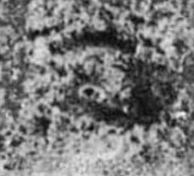
Posted by: tedstryk Mar 20 2011, 12:14 AM
I made mosaics with the fragments I could find. I had a version I posted once upon a time that extended to the horizon on the right, but I was less than sure that I had connected those images correctly, so I made a separate panorama out of them (the last image in the blog post). http://planetimages.blogspot.com/2010/03/luna-20.html
Posted by: kenny Mar 20 2011, 01:58 PM
Very nice panos. The pair on your blog illustrate the ability of the arm to move left-right (in azimuth) and both shots are seen to have been made post-drilling - assuming Smolders was correct in 1973, and his white box does indeed enclose the hole. Phil's atlas has a nice photo which convincingly shows the same area before drilling, and it looks quite different.
Posted by: Phil Stooke Mar 23 2011, 04:14 PM
Kenny asked me this question privately, but I thought the answer might be of more general interest so (if you'll forgive me, Kenny) I will post it here.
I tried to identify the Luna 20 landing site in my lunar atlas, based on a proposed match between the surface images and Lunar Orbiter images. It was the same position suggested earlier by George Burba. Kenny asked how far I was from the LROC position. I hadn't checked, so here is my answer after a careful comparison of the images. I was about 7 km out! That is comparable to the uncertainties at most lunar sites until you can narrow it down with images. Needless to say, my image analysis was off, and I will have to go back into the pictures and try to figure out why. Oh well, at least I tried!
Phil
Posted by: Explorer1 Mar 24 2011, 06:39 AM
I suppose this is as good a place as any to ask; has Luna 2's impact site been seen by LRO, or is it even possible? A search didn't tell much, it would be nice to see the oldest artificial crater on another object (1959)!
Posted by: Hungry4info Mar 24 2011, 07:52 AM
Hasn't been found as far as I know, and I would not be surprised if it's location is highly uncertain.
Posted by: kenny Mar 24 2011, 09:37 AM
No problem re Luna 20, Phil. Rather than post it publicly initially, I was giving you some thinking time!
Your 2007 position was a really good interpretation from the somewhat fuzzy horizon hills, I thought. And the main error was in range to the horizon, so the analysis of the skyline was pretty spot-on.
Good detective work updated by new data. It's so fascinating to see all this stuff emerge from its previous obscurity.
Posted by: Phil Stooke Apr 3 2011, 06:27 PM
Looking ahead to the next Russian missions...
Check out these presentations on Luna-Glob and Luna-Resource site selection!
Phil
http://www.iki.rssi.ru/conf/2011-lg/presentations/
Posted by: Paolo Nov 4 2018, 07:57 PM
apparently a tiny Luna 16 sample is to be auctioned, if you have a spare million...
https://www.rferl.org/a/moon-rocks-collected-soviet-unmanned-space-mission-luna-16-expected-fetch-1-million-dollars-at-auction-sothebys-new-york/29574237.html
the article does not mention it, but I remember a similar sample from Luna 20 being auctioned in the early 1990s.
Posted by: Steve G Jul 7 2020, 03:40 PM
Some good news about Russia's Luna 25, that it's still on-track for an October 1, 2021 launch.
http://en.roscosmos.ru/21544/
Posted by: Paolo Oct 27 2020, 08:14 PM
check out this Roskosmos release for the 50th anniversary of Luna 16 last September!
lots of documents, images and videos (I had never seen the details of how the sampling system really worked shown in the 2nd video)
https://www.roscosmos.ru/29219/
video links:
https://www.youtube.com/watch?v=zFyQZz9BPVg
https://www.youtube.com/watch?v=l-qVNnQDRio
https://www.youtube.com/watch?v=sg2-g0qGOo8
Posted by: Paolo Oct 28 2020, 01:04 PM
I have grabbed from one of the videos in the previous post four Luna 12 images. I have checked my references, and I am not sure that these have been published before. Maybe Phil Stooke can confirm this.
Posted by: Phil Stooke Oct 28 2020, 04:17 PM
Interesting! They seem new to me, but the first has vertical lines which look a bit like the framelets in Lunar Orbiter images. I will have to give this some thought. They were shot on film and scanned and transmitted like the Luna 3 (and Lunar Orbiter) images.
EDIT: OK, now I am a bit suspicious. First, the video clearly uses at least one Lunar Orbiter image, the famous "Picture of the Century" oblique view across Copernicus crater. That was Lunar Orbiter 2 which flew after Luna 12, so the video date must be later than that.
Second - look at image 3 from Paolo. 4 horizontal dark lines separate the image into 3 horizontal bands with a bit extra top and bottom, Within each band are vertical fainter light and dark lines. Those look very much like Lunar Orbiter image features (framelet boundaries and scan lines) and are not obvious in the four Luna 12 images I have seen and included in my old atlas. (See also http://mentallandscape.com/C_CatalogMoon.htm). I will acknowledge that there are very faint markings a bit like that in those Luna 12 images, but nothing like as clear as in Lunar Orbiter images. On the other hand the lighting in the third image shows that the framelets run north-south which limits it to lunar Orbiter 4 and 5. It's all a bit confusing. Also why is the time stamp not using a Cyrillic 'L'?
At the moment I don't know what to think. I certainly don't have time to search through all 2500 Lunar Orbiter images to try to find them! So I will just say I am confused. If anyone looks at Lunar Orbiter images now, note that modern processing has removed many of these artifacts, so you really need to look at older prints or scans.
Phil
Posted by: Shan Nov 4 2020, 02:38 PM
If I am right this could be the one
Took the impact site from this one - http://strabo.moonsociety.org/publications/selenology/selenologyspring2009.pdf
It says that actual impact might be near 4.97E and 25.7N and the below one might be very well the rocket impact stage but not sure
https://quickmap.lroc.asu.edu/query?extent=5.3155037,25.7721546,5.3640308,25.7965476&proj=16&features=5.34486081,25.78178372,5.34488719,25.78079438,5.34707693,25.78051737,5.34677353,25.78188925,5.34486081,25.78178372&selected=0&query=95&layers=NrBsFYBoAZIRnpEBmZcAsjYIHYFcAbAyAbwF8BdC0yioA
Posted by: Paolo Nov 16 2020, 09:22 AM
and now we are getting a similar quantity of documents, pictures, videos etc on Lunokhod 1 for its 50th anniversary!
well done, Roskosmos!
https://www.roscosmos.ru/29563/
Posted by: Shan Nov 17 2020, 02:46 AM
well done, Roskosmos!
https://www.roscosmos.ru/29563/
The panorama images are beautiful & are in much good shape
There are lot of images - http://www.planetology.ru/panoramas/lunokhod1.php?page=1&language=english
Powered by Invision Power Board (http://www.invisionboard.com)
© Invision Power Services (http://www.invisionpower.com)

